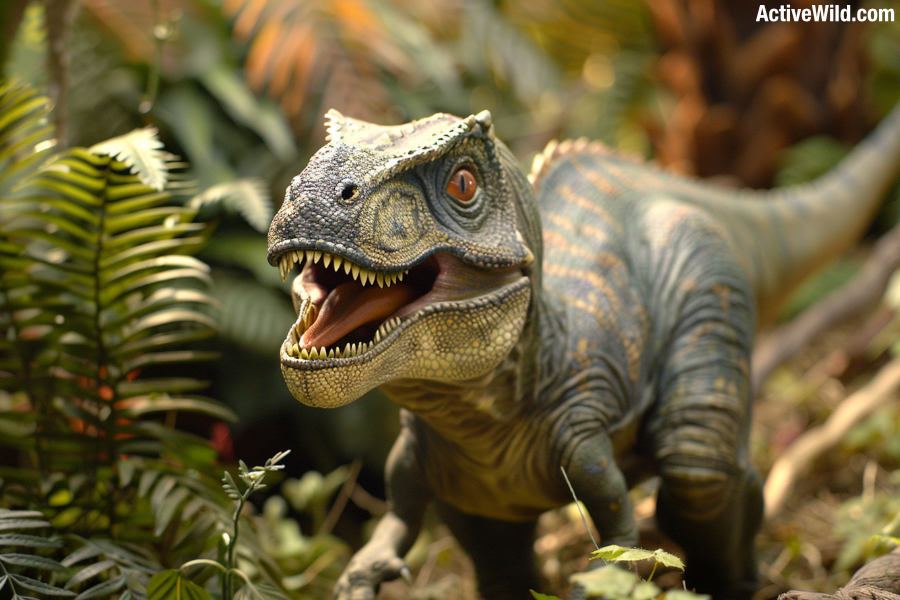Herrerasaurus, one of the earliest known dinosaurs, is pivotal in our understanding of dinosaur evolution.
First discovered in Argentina’s Ischigualasto Formation, this Triassic predator roamed the Earth approximately 230 million years ago, a time when the landscape of the supercontinent Pangaea was dramatically different from today.
Page Index
Herrerasaurus Facts
- Type of Dinosaur: Theropod
- Diet: Carnivore
- Continent(s) Found: South America (specifically in what is now Argentina).
- Length: 3 to 6 meters (10 to 20 feet);
- Weight: 210 to 350 kilograms (460 to 770 pounds).
- Period: Late Triassic Period, around 231 to 229 million years ago.
What Did Herrerasaurus Look Like?


Herrerasaurus was a relatively compact, early theropod dinosaur, measuring about 10 to 20 feet / 3 to 6 meters in length and weighing approximately 460 to 770 pounds / 210 to 350 kilograms.
It had a slender, agile body with a long tail, which likely aided in balance. Its head was equipped with sharp teeth, indicative of its carnivorous diet.
Herrerasaurus was bipedal (i.e., it walked on two legs) and had short forelimbs with sharp claws. Its build suggests it was a swift predator, capable of quick movements to catch smaller prey. Its appearance was likely streamlined, with a somewhat narrow skull and forward-facing eyes, providing good binocular vision essential for hunting.
Only one species of Herrerasaurus is known: Herrerasaurus ischigualastensis.
Where Did Herrerasaurus Live?


Herrerasaurus lived in what is now Argentina. It is one of the most commonly-found dinosaurs in the Ischigualasto Formation in the northwestern part of the country. (All known Herrerasaurus specimens are from this area.)
During the Late Triassic period, when Herrerasaurus existed, this area was a volcanically active floodplain with a variable climate that likely included distinct wet and dry seasons. This region has provided a wealth of fossils that help scientists understand the early diversification of dinosaurs.


When Did Herrerasaurus Live?
Herrerasaurus lived during the Late Triassic period, approximately 231 to 229 million years ago. This places it among the earliest dinosaurs, providing valuable insights into the early stages of dinosaur evolution.
Earth During The Triassic Period
During the Triassic Period, approximately 252 to 201 million years ago, Earth was a vastly different place.
The planet’s continents were united into a single supercontinent called Pangaea, characterized by extreme climates with pronounced dry seasons and monsoons. The environment ranged from vast deserts to lush river valleys.
This period marked a significant recovery from the Permian mass extinction, leading to the emergence and diversification of early dinosaurs (including Herrerasaurus), reptiles, and the first mammals.
What Dinosaurs And Other Animals Did Herrerasaurus Live With?
Herrerasaurus shared its habitat with a variety of other early dinosaurs and pre-dinosaurian creatures in the Ischigualasto Formation of Argentina. Some of the notable contemporaries include:
- Eoraptor – Another of the earliest known dinosaurs, Eoraptor was a small, lightly built dinosaur that is thought to have been omnivorous.
- Pisanosaurus – A small, early herbivorous dinosaur, which might represent one of the earliest ornithischian dinosaurs.
- Saurosuchus – A large archosaur predator that was not a dinosaur but was part of the group that includes modern crocodiles and their ancestors. It was one of the apex predators of its environment.
- Ischigualastia – A large herbivorous dicynodont, a group of synapsid reptiles, which survived from earlier periods and lived alongside early dinosaurs.
- Hyperodapedon – A rhynchosaur, which was an herbivorous reptile common during the Triassic period.
Conclusion
Herrerasaurus is one of the earliest known dinosaurs, and its discovery has aided our understanding of dinosaur evolution.
By examining the life of this ancient carnivore, we gain invaluable insights into the dawn of the Age of Dinosaurs and the evolutionary paths that led to the rise of these iconic creatures.
More Dinosaurs On Active Wild
Discover different dinosaurs from each of the three periods of the Mesozoic Era:

